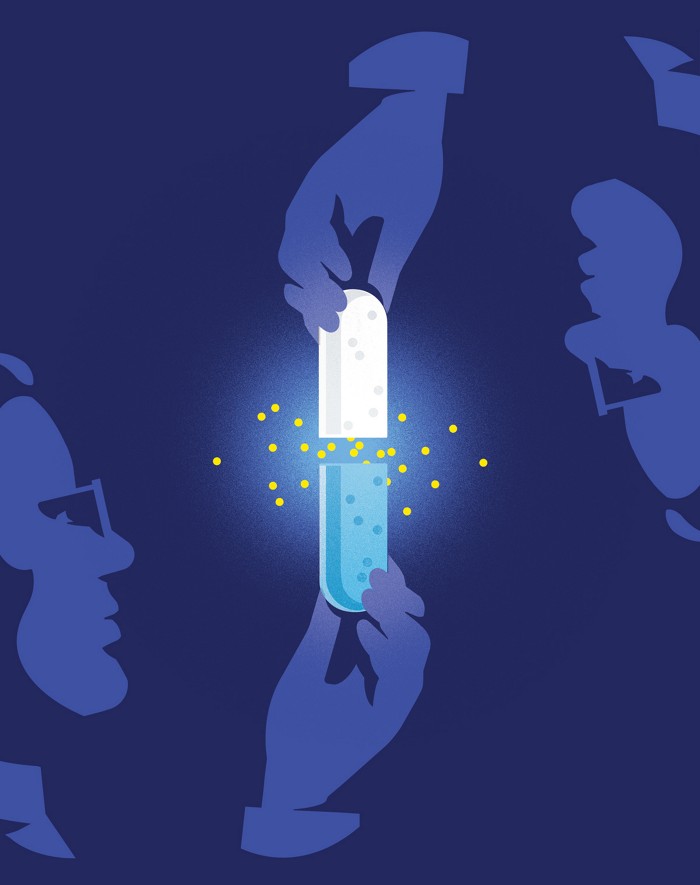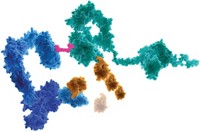Advertisement
Grab your lab coat. Let's get started
Welcome!
Welcome!
Create an account below to get 6 C&EN articles per month, receive newsletters and more - all free.
It seems this is your first time logging in online. Please enter the following information to continue.
As an ACS member you automatically get access to this site. All we need is few more details to create your reading experience.
Not you? Sign in with a different account.
Not you? Sign in with a different account.
ERROR 1
ERROR 1
ERROR 2
ERROR 2
ERROR 2
ERROR 2
ERROR 2
Password and Confirm password must match.
If you have an ACS member number, please enter it here so we can link this account to your membership. (optional)
ERROR 2
ACS values your privacy. By submitting your information, you are gaining access to C&EN and subscribing to our weekly newsletter. We use the information you provide to make your reading experience better, and we will never sell your data to third party members.
Drug Discovery
Why small-molecule drug discovery is having a moment
With medicinal chemists’ innovative tools and techniques, it’s an exciting time to be building new drugs
by Laura Howes
October 30, 2023
| A version of this story appeared in
Volume 101, Issue 36

In brief
At one stage, small-molecule drugs seemed at risk of going out of fashion, as industry began to favor biotherapeutics. But over the past 10 years, small molecules have made it clear that they aren’t going away. New classes of molecules, such as proteolysis-targeting chimeras (PROTACs) and molecular glues, have people excited. So do technologies, such as machine learning and generative artificial intelligence, that are helping drive drug discovery. Today, drug hunters have more ambition to go after difficult targets and to use novel chemistry. And that makes it an exciting time for chemists.
Last year, sales of the 10 top-selling drugs were split 40:60 between small molecules and larger, more complicated biologics, according to Drug Discovery and Development. But those numbers are skewed by the huge cost of some biologic blockbusters. On a global scale, around 90% of all drugs sold are small molecules, according to a Medicine in Drug Discovery paper (2021, DOI: 10.1016/j.medidd.2020.100075).
Not too long ago, these small-molecule drugs looked as if they were going out of fashion. Advances in biotechnology enabled pharmaceutical companies to cost-effectively generate a range of biologics, such as large peptides, recombinant proteins, monoclonal antibodies, antibody-drug conjugates, fusion proteins, and vaccines.
But organic compounds with low molecular weight—molecules that can be administered orally and can pass through cell membranes to reach intracellular targets—have been a mainstay of the pharmaceutical industry for over 100 years. Rather than fade away, they continue to be an important part of the industry’s therapeutic arsenal. In the past 10 years or so, advances in technology, synthetic methodology, and biopharmaceutical research have opened up more opportunities for innovative and creative small-molecule drugs.
Data from the US Food and Drug Administration show that small molecules continue to play a vital role in the pharmacopoeia. Of the 293 new chemical entities that the FDA approved in 2017–22, 182 were small-molecule drugs.
In the mix


And drug developers are learning new ways to use small molecules to target disease. The traditional approach to drugging many diseases was to find a molecular key that could fit inside a protein, blocking off part of its 3D shape and inhibiting its activity. Increasingly, researchers are instead using small molecules to covalently bind to proteins or to bring proteins near one another so they can work together.
Rather than losing their attractiveness in the modern world of biological advances, small molecules are having something of a renaissance. There’s a buzz and a feeling that medicinal chemists can design solutions for diseases they once would have considered impossible to confront.
New modes of action
Many chemists would agree that there is a renewed enthusiasm for what medicinal chemists can do, even if they wouldn’t call it a golden age. Keith Hornberger, who leads a team of medicinal chemists at the biotechnology firm Arvinas, says golden age is not the right moniker. “I’d say it’s the new age,” he says. New uses for small molecules are ones that were never considered 20 years ago and have redefined what chemists think of as druggable.
The biggest change, experts say, is the possibilities opened up by covalent inhibitors and induced-proximity molecules, molecules that go beyond the lock-and-key approach to targeting unwanted proteins.
Covalent drugs can grab hold of reactive amino acids on proteins, even when a suitable pocket, or keyhole, does not exist. One high-profile example is the work of Kevan Shokat of the University of California, San Francisco, and his team. In 2013, Shokat’s group found a way for a drug to covalently bind to a cysteine in a cancer-causing mutant of KRas and inhibit the protein. Today, it’s not just cysteines that can be targeted but many other reactive amino acid side chains as well.
And the most well-known examples of induced-proximity targeting are the proteolysis-targeting chimeras, or PROTACs, first developed by Craig Crews’s laboratory at Yale University. These floppy molecules with binders at both ends can draw together two proteins in a cell and add ubiquitin tags to flag the protein of interest for degradation.

Chemists have also since extended the approach to create a host of variants. These include regulated induced proximity targeting chimeras (RIPTACs), which hold on to, stabilize, and inhibit problem proteins, and lysosome-targeting chimeras (LYTACs), which specifically mark extracellular proteins for destruction. These molecules draw together proteins involved in cancer to cause cell death or pull extracellular proteins into the cell for destruction. Chemists can also now create molecules that try different posttranslational modifications, such as deubiquitination, phosphorylation, and acetylation.
These long molecules might not look like the small-molecule drugs of the past, and they don’t have the characteristics that traditionally make a good small-molecule drug. But clinical trials have shown that the molecules can get into cells and effectively treat different cancers.
No PROTACs have yet jumped over the final regulatory hurdles and won approval. But experts say the induced-proximity concept has proved its naysayers wrong and that it’s just a matter of time before such a drug makes it to market.

Meanwhile, molecular glues are smaller ways to induce degradation using ubiquitination. They work by glomming on to one protein to change its affinity for another protein in the cell.
Molecular-glue firms are now signing deals with Big Pharma. For example, Proxygen has inked deals with both Merck KGaA and Merck & Co. to develop molecular glues as degraders in the last year. And Monte Rosa Therapeutics’ latest collaboration is with pharma firm Roche to develop glues against cancer and neurological disease targets previously thought undruggable.
Looking back, Hornberger says, these developments came from the careful structural work of chemical biologists like Shokat. This work helped medicinal chemists move away from the lock-and-key paradigm of protein inhibition. Today, many medicinal chemists are looking for different toeholds and ways to alter protein behavior.
“If you would have told medicinal chemists 15, 20 years ago that we’d be doing chemistry in cells, we would just laugh at that, but that’s what we’re doing,” says Joel Barrish, an industry veteran now at RA Capital Ventures. “I mean, we are basically taking control of the natural regulatory mechanisms.”
And it’s not just proteins that can be targeted. A key area of small-molecule research is the identification and development of molecular entities capable of targeting RNA. For a long time, human RNA was thought to be undruggable, but researchers now know that RNA assumes 3D structures, creating binding sites for small molecules to interact with.
“My personal opinion is that the next big thing is nucleic acids,” says Zoë Waller, an associate professor in drug discovery at University College London. “Targeting nucleic acids was a specialist area, but it is really becoming more mainstream now.”
One company working on RNA binding is Arrakis Therapeutics, cofounded by chemist Jennifer Petter. She says the firm is working on multiple approaches for silencing RNA, including binding a regulatory section to modify biology directly, inducing RNA degradation, and even covalently binding the polynucleotide. “Within our walls, we actually have a multimodality small-molecule shop,” she says.
How small is small?
But not all those molecules are so small.
Twenty-five years ago, Christopher A. Lipinski created a set of rules, or guidelines, to describe the characteristics of successful small molecules that could be taken orally. Dubbed the rule of 5, they were based on observations that successful drug candidates were often smaller than 500 g/mol in mass and lipophilic. But not all the drugs being developed by medicinal chemists fit those criteria, nor have they ever.
Today, medicinal chemists are making larger and larger molecules. Called beyond-rule-of-5 molecules, these can include bifunctional drugs like PROTACs as well as much larger molecules, such as cyclic peptides. “So what is small anymore?” Barrish asks.

Matthew Disney is a chemist at at the Herbert Wertheim UF Scripps Institute for Biomedical Innovation and Technology at the University of Florida who founded Expansion Therapeutics to develop small molecules to bind to RNA structures. He has also noticed the trend toward larger molecules. “FDA-approved drugs are getting larger in size,” Disney says. “Industry putting things out in the literature to sort of show that these bigger molecules can be orally bioavailable—I think it just makes the science better for everybody.”
Developing those larger molecules requires medicinal chemistry. “I don’t think you can make medicine without organic chemists. Both academic and industry,” Disney says. “You need the academics to make new methods and industry to deploy them. You need synthetic people in addition to chemical biologists, bioinformatics, and biologists.”
And the chemists involved need new synthetic methods to add to their tool kits, according to Matthew Todd, who builds open-source medicinal chemistry projects in his academic lab at University College London. One such development is the skeletal editing techniques that can swap atoms in and out of molecular structures. A recent example can swap a carbon out for a nitrogen in an aromatic ring.
These new synthetic tools give medicinal chemists more options and can help them build on molecules that are shown to bind to a target but perhaps not so well. “Combining these with the prevalence of covalent molecules and the prevalence of degraders opens up things that you can do with molecules,” Todd says.
Petter agrees. “If you’re willing to take on the larger molecules, this opens up the possibility for some really remarkable, innovative molecular designs,” she says.
Technological developments
Industry insiders point out that chemists would not be making these strides without advances in biology and instrumentation. “It’s advancements of science, overall,” RA Capital Ventures’ Barrish says. “It’s advancements in chemistry and technologies that really are allowing us to begin to access [targets and biology] that we hadn’t been able to do before.”
Those technological leaps began in the 1980s with improvements in structural biology, including the development of cryo-electron microscopy and high-resolution X-ray crystallography techniques that allow scientists to visualize biology in atomic detail. But they also involve the bioinformatic screens and assays that can test for places where a protein can interact with another protein.
Genetic screening also helped medicinal chemists’ efforts by finding new links between genes and diseases so that drug hunters could identify new drug targets. And perhaps unsurprisingly, Petter says that improvements in genetic sequencing have hugely helped her work developing RNA-targeting molecules.
Another change has been the externalization of services, such as compound library design. The proliferation of contract research organizations and other service firms means that biotechs can buy the chemical expertise they need rather than have to develop it themselves. And those firms can also drive technological innovation—for example, by building DNA-encoded libraries or on-demand compounds.
The services from these molecule-on-demand firms have “really altered things,” Todd says. “We’ve been looking at all the molecules that you can buy, and we’re trying to think of ways of expanding that by synthesizing new core building blocks, which you can then decorate with other things that you can buy.”
Advertisement
These modular building blocks, and the ways they have been described computationally, also primed researchers to experiment with how to use artificial intelligence and machine learning to help design new drugs. Historically, computational methods helped drug hunters and builders model new small-molecule therapeutics without actually having to synthesize them. That trend has continued with AI-driven start-ups, which are either solely or partially focused on small-molecule drug discovery.
According to a report by BiopharmaTrend, about 45% of all drug discovery start-ups that use or develop specialized AI tools are focused on small molecules, while only about 24% are working to develop biologic drugs. The figures are similar for the cash being invested in these firms by venture capitalists.
No one expects computers to replace medicinal chemists, but many scientists think AI can help them. Several drug discovery companies with AI-powered platforms have recently progressed molecules to the clinic, sometimes faster and cheaper than might be expected with other techniques.
“That’s where the golden opportunity arises: that we can have a renaissance with better small molecules with AI coming in,” UCL professor Waller says.
But is it a golden age?
Today, small molecules can do many of the same things that biologic drugs can do and find financial success doing so. For example, among the drugs that treat spinal muscular atrophy are Zolgensma, a onetime gene therapy injection; Spinraza, an antisense oligonucleotide given as an injection into the spine every few months; and, since 2020, a daily small-molecule treatment Evrysdi (risdiplam) given as an oral solution. Evrysdi racked up over $1 billion in sales in 2022, and its sales in the first half of this year grew by 48% from the same period in 2022, while sales of Zolgensma and Spinraza fell.
Small molecules are often effective and cheap, especially once they come off patent. And they can be easier than biologics to store and take as a patient. As researchers understand more about how diseases and drugs work at a molecular level, older molecules whose mechanisms were perhaps not understood when they were first developed can become useful once more.

The pharmaceutical industry is over 100 years old, and for many, the true golden age of drug discovery ran from the 1940s to the 1970s. Small-molecule drugs from this era, such as antidepressants, antipsychotics, and oral contraceptives, were truly revolutionary. Instead of calling today the golden age, chemists are using different terms: a new golden age, a new age, a renaissance, or a renewal.
Biotech entrepreneur Ethan Perlstein, who is trying to repurpose existing small molecules to treat metabolic disorders, contends that the golden age never ended—people just got distracted by other therapeutic modalities. There is an element of fashion to research, and “small molecules is a terrible term for marketing,” he says.
As drug hunters gaze into their crystal balls, small molecules are still a key part of the medicinal arsenal. But perhaps more and more, what those molecules look like will change. “I envision there will be types of drugs that will look weird to us because they don’t look like what we’re expecting,” Waller says. “And that’s what we need. . . . There’s so much potential there.”
CORRECTION:
This article was updated on Oct. 31, 2023, to correct Matthew Disney’s affiliation. He is based at the Herbert Wertheim UF Scripps Institute for Biomedical Innovation and Technology at the University of Florida, not Scripps Research.




Join the conversation
Contact the reporter
Submit a Letter to the Editor for publication
Engage with us on Twitter